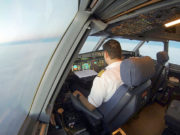Reducing the size of airline crews to a single pilot would result in safety risks that outweigh the associated cost savings and other potential benefits, according to a report released Wednesday by the Air Line Pilots Association, International (ALPA).
The ALPA White Paper: The Dangers of Single-Pilot Operations said that most proposals to reduce the size of the typical two-pilot flight crew emphasize the cost savings that would result.
“However,” the report said, “the current body of evidence and experience, including more than a decade of study by the [U.S.] National Aeronautics and Space Administration (NASA) and the [U.S.] Federal Aviation Administration (FAA), shows that the safety risks and challenges associated with single-pilot operations far outweigh its potential benefits.”
Single-pilot operations constitute “a risk not worth taking,” the report added.
Much of the risk is associated with the increased workload for a single pilot, the elimination of “a critical layer of monitoring and operating redundancy in the cockpit” and the inability of a single pilot to handle many emergency situations, the report said.
Having two pilots seated side by side enables close coordination, the report said citing NASA research that found that coordination suffers when pilots are separated ─ for example, if one pilot is operating from a remote setting. “These studies found instances of confusion increase when pilots are not co-located and that replacing nonverbal cues with verbal communications adds an impractical number of tasks to the pilot’s workload,” the report said.
The use of autonomous systems can result in complacency and a resulting decline in effective monitoring, as well as the degradation of pilot situational awareness, the report said, adding that if an unexpected event occurs, “pilots who have been using autopilot for an extended period of time can have difficulty transitioning back to active mode.”
In addition, the report said, the incapacitation of the pilot during single-pilot operations “could be catastrophic.”
The report also noted that public opinion overwhelmingly favors keeping two pilots in the cockpit. A 2018 survey concluded that 80 percent of the U.S. public supported the idea of “two pilots working together,” while 81 percent said they “would not be comfortable” in an airplane with no onboard pilots.


